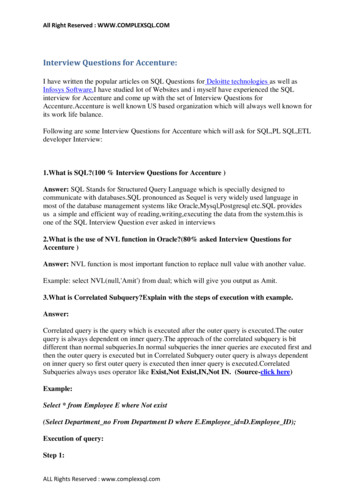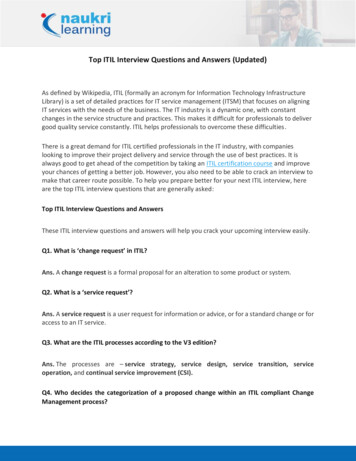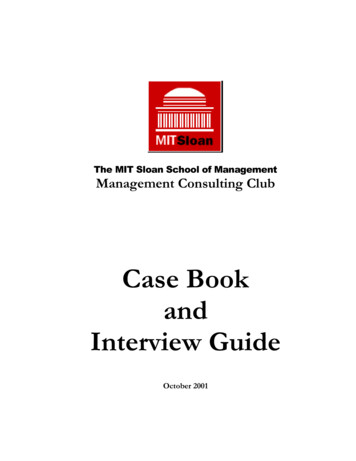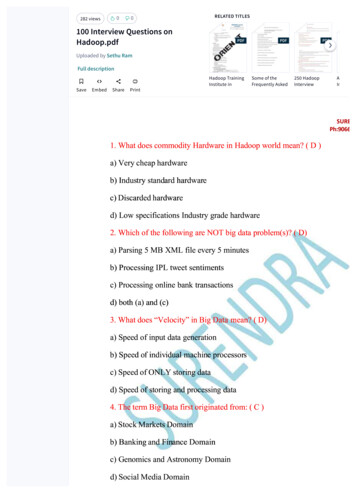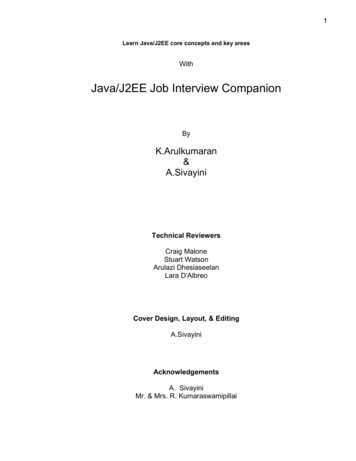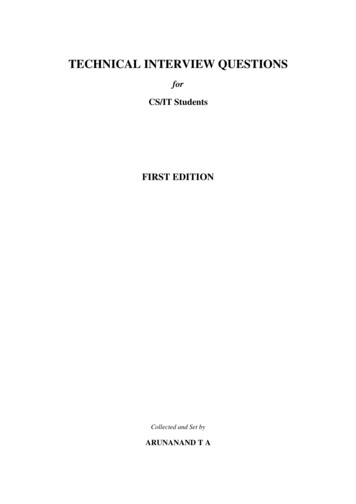
Transcription
TECHNICAL INTERVIEW QUESTIONSforCS/IT StudentsFIRST EDITIONCollected and Set byARUNANAND T A
Technical Interview Questions for CS/IT StudentsPage 2 of 44Exclusively Prepared forCOLLEGE OF ENGINEERING CHENGANNURAlappuzha District, Kerala, India - 689121DEPARTMENT OF COMPUTER ENGINEERINGPrepared for College of Engineering Chengannur, Kerala, INDIAPage 2 of 44
Technical Interview Questions for CS/IT StudentsPage 3 of 44TECHNICAL INTERVIEW QUESTIONS(for CS and IT students)Prepared for College of Engineering Chengannur, Kerala, INDIAPage 3 of 44
Technical Interview Questions for CS/IT StudentsPage 4 of 44 All Rights ReservedExclusive rights by the author. No part of this publication may be reproduced, changed,distributed in any form or by any means, or stored in a database or a retrieval system, withoutthe prior written consent of the author, including, but not limited to, in any network or otherelectronic/mechanical/electrical/magnetic or any other storage or transmission, or broadcastfor distance learning or any other purpose.Prepared for College of Engineering Chengannur, Kerala, INDIAPage 4 of 44
Technical Interview Questions for CS/IT StudentsPage 5 of 44ABOUT THE AUTHORArunanand T A was born on 11th April, 1989 atNayarambalam, a small village in the island of Vypin,Ernakulam Distirct, Kerala. He did his secondary and highersecondary schooling at BVHS, Nayarambalam and SMHSS,Cherai respectively. After taking graduation in B.TechComputer Science and Engineering from College ofEngineering Chengannur, Kerala (affiliated to CochinUniversity of Science and Technology) he’s currently preparing for his Mastersprogram in Engineering.His father is Mr. Anandan T N and mother Ms. Kumari Anandan. He’s currentlyresiding at his native place referred to below.Address: Thayyathazhath H, Nayarambalam P O, Ernakulam, Kerala, India – 682509.Contact No: 91 – 9495 087 682.E-mail: arunta007@gmail.comMore about the Author: http://www.arunanand.com http://www.cecblog.comPrepared for College of Engineering Chengannur, Kerala, INDIAPage 5 of 44
Technical Interview Questions for CS/IT StudentsPage 6 of 44This page is intentionally left blankPrepared for College of Engineering Chengannur, Kerala, INDIAPage 6 of 44
Technical Interview Questions for CS/IT StudentsPage 7 of 44CONTENTS1.PREFACE82.TO STUDENTS93.SUGGESTED READINGS4.Chapter I: INTRODUCTION5.Chapter II:6.Chapter III:7.Chapter IV:8.Chapter V:9.Chapter VI:10.Chapter VII:11.Chapter VIII:12.Chapter IX:13.Chapter X:14.Chapter XI:15.Chapter XII:16.Chapter XIII:17.Chapter XIV:18.Annexure I: APPLYING FOR JOBS - LETTERS19.Annexure II:20.Annexure III: CV COVERING LETTER21.Annexure IV: APTITUDE TEST TIPS22.Annexure V: GROUP DISCUSSION TIPS22.Annexure V: TIPS FOR INTERVIEWS10CURRICULUM VITAE – TIPS ANDMODELPrepared for College of Engineering Chengannur, Kerala, INDIAPage 7 of 44
Technical Interview Questions for CS/IT StudentsPage 8 of 44COMMON HR INTERVIEWQUESTIONS AND ANSWERS23.24.Annexure VI: RECOMMENDATION LETTERS25.Annexure VII: GATE EXAMINATION26.Annexure VIII:ADMISSION TO M.TECHSUBSTITUTES FOR GATE27.Annexure IX:RANKING OF MAJOR TECHNICALINSTITUTIONS FOR M.TECH28.Annexure X: GATE – CUT OFFS29.Annexure XI:30.NotesCOMPETITIVE EXAMINATIONSFOR B.E/B.TECH/M.E/M.TECHPrepared for College of Engineering Chengannur, Kerala, INDIAPage 8 of 44
Technical Interview Questions for CS/IT StudentsPage 9 of 44PREFACEThis book is intended to help the students from technical backgroundsperform well in their technical interviews. Questions presented herein are fromauthor’s personal experience or collected his friends, teachers, magazines, books orother online resources.The books aims at providing a coherent approach in technical subjects;however, apart from technical topics, some headlines of general interest for technicalstudents have also been included as annexure at the end of this publication.A Word of ThanksI would like to thank all those who have helped me in preparing thisdocument, especially my teachers and friends at College of Engineering Chengannur, Keralaand ACE Engineering Academy, Hyderabad for assisting me. Special thanks to Ms. NishaKuruvilla, Asst. Professor in Dept. of Electronics Engineering and the Placement Officer atCollege of Engineering Chengannur, who encouraged me in writing this booklet.I extend my thanks to all those who have shown a good heart towards theattempt, especially to Mr. Fredie Thomas, Mr. Viswajith V Kurup, Mr. Sanoop Thomas andMr. Abin John George.Suggestions InvitedSuggestions and inclusions are invited from teachers, experts, enthusiasts andstudents. Kindly send me your comments and new questions to: arunta007 [at] gmail [dot]comDisclaimerThis document contains questions collected from various students, teachers,magazines, online resources and/or set by the author. However, the author will not bear anyresponsibility over any kind of discrepancies that might have crept in while setting thedocument.Ernakulam,25-Nov-2010.Prepared for College of Engineering Chengannur, Kerala, INDIAARUNANAND T APage 9 of 44
Technical Interview Questions for CS/IT StudentsPage 10 of 44TO STUDENTSFirst of all, let me thank you for having a look at this booklet. As you wouldprobably understand, this book contains some tentative or likely or, rather, potentialquestions for a technical interview a CS/IT student may face. I would like to emphasize onthe word potential as there is no sure about whether any of the questions presented herein willbe asked in an interview or not. It depends on the domain for which interview takes place,and the level of knowledge the company expects from you. You may, perhaps, face not evena single question from this collection, and sometimes, most of your interview may be on thetopics covered herein.Hence, my sincere advice to you is that you consider this booklet as aguideline, or as a model, which may help you understand how to prepare for a technicalinterview. Remember, Google and Wikipedia are your best friends, always! However, neverdo avoid text books. I have some suggestions in this regard, which I have kept in the nextpage.And I am sorry to inform you that I have not added all the solutions to thequestions. It’s the sole responsibility of the aspirants to find them out. However, to youradvantage, hints to some vital questions have been provided wherever necessary.Wish you all the best in your knowledge and job hunt!Ernakulam,25-Nov-2010.Prepared for College of Engineering Chengannur, Kerala, INDIAARUNANAND T APage 10 of 44
Technical Interview Questions for CS/IT StudentsPage 11 of 44SUGGESTED READINGSHere are some suggested readings an undergraduate student of CS/IT shouldrefer to. Nevertheless, they may, perhaps, not be the best text available in the market. This issimply from my experience.Some text books are written by Indian author, some by foreign authors andsome by both. It’s also to be noted that these are the widely used text books for competitiveexaminations and technical interviews. Mathematics“ Higher Engineering Mathematics” by B.S.Grewal Automata Theory and Computation (Theory of Computation)“Formal Languages and Automata theory” , J.D.Ullman Design and Analysis of Algorithms“Introduction to algorithms” – Cormen etal ( CLRS )“Computer Algorithms” – Horowitz and Sahani Digital Logic“Digital Logic circuits and Design” by Morris Mano Computer Architecture and Organization“Computer Organisation” by Morris Mano” Computer Architecture” by Briggs Data structuresPrepared for College of Engineering Chengannur, Kerala, INDIAPage 11 of 44
Technical Interview Questions for CS/IT StudentsPage 12 of 44“Data structures” Schaumm’s outline series“Data structures in PASCAL” by Horowitz and Sahani“Data structures and Algorithms” by Weiss“Introduction to Algorithms” – Cormen C/C Programming“Programming with C” – Byron Gottfried , Schaumm’s outline series“Principles of Programming Languages” by Robert W Sebesta , Addison Wesley“Programming with C ” – Balaguruswamy Compiler Design“Principles of Compiler Design” , Aho , Ullman etal .“Systems Programming” by John . J . Donovan Operating Systems“Operating system concepts” by Abraham Silberschatz and Peter Galvin Databases“Principles of Database Systems” – J.D.Ullman“Database system concepts” – Silberschatz , Korth , Sudarshan“Database systems” – C.J.Date Computer Networks“Computer Networks” – Tenenbaum“Data communications and Networking” – William Stallings Some more important books :“Multiple choice questions” – Timothy . J . Williams , TMH publications“Gate Question Papers ” – G.K.Publishers.“Aptitude – Verbal and Non-Verbal” by AggarwalPrepared for College of Engineering Chengannur, Kerala, INDIAPage 12 of 44
Technical Interview Questions for CS/IT StudentsPage 13 of 44Dedicated to my friends at CEC Without whomI couldn’t have completed this workandI wouldn’t have understood the real joy of life.Prepared for College of Engineering Chengannur, Kerala, INDIAPage 13 of 44
Technical Interview Questions for CS/IT StudentsPage 14 of 44CHAPTER 1INTRODUCTIONPOTENTIAL TECHNICAL INTERVIEW QUESTIONSFollowing are some potential questions (from core subjects only) those can be expected in theCS/IT Technical Interviews. Questions are classified subject-wise. These questions arecollected from various students who have undergone such interviews, internet, somemagazines and M.Tech/ME/MS students who had to face such questions during theiradmission to institutions of national importance.N.B: Some Electronics subjects that still have strong relation with CS/IT branches, likeDigital Electronics, Microprocessors, Data Communication, etc. are not included in thisdocument. Students may expect questions from such subjects also.Also, students are advised to get themselves updated with recent technologies released in themarket, some key technologies like system architectures, distributed/cloud/gridnetworking/computing, and general questions like Von-Numann Architecture, Moore’s Law,etc.Prepared for College of Engineering Chengannur, Kerala, INDIAPage 14 of 44
Technical Interview Questions for CS/IT StudentsPage 15 of 44CHAPTER IIDATA STRUCTURES(Students are supposed to be well aware of the programming concepts using Arrays, LinkedLists, Trees and Graphs. It’s likely that the interviewer may provide you with a scrap ofpaper and ask to write down certain program modules. This is applicable to all thosesubjects which involves programming portions)1. Why do we require data structures?2. What is the difference between a physical structure and a data structure?3. If I say that linked list is a linear data structure, will you assent to me?4. What is the difference between a B Tree and B Trees? Have they got any similarities?5. What do you know about AVL rotation?6. What is the last thing you learned about data structures from a book, magazine or website?7. You might have used 2-D arrays while programming. But you know that our mainmemory is of one dimension. How is it possible to establish this?8. What is FIFO?9. Can you differentiate between Array and Linked List? Which one is linear and what arethe advantages being linear?10. What do you mean by a circular queue? Can you suggest a situation where we can usethis?11. What do you mean by rear and front end of a queue?12. (This question is normally a continuation of the above question)What if I insert at the rearend and delete from the front end, what will happen?13. Have you ever used priority queues? Where do we use them in practical applications?14. How can a stack be implemented? Which one do you prefer? Why?15. What would you imagine the problems that could happen if the data structures didn’texist?Prepared for College of Engineering Chengannur, Kerala, INDIAPage 15 of 44
Technical Interview Questions for CS/IT StudentsPage 16 of 4416. How do you explain what a data structure means, to a 12-year old nephew of yours?17. Suppose you are a teacher and a student comes to you with his ambiguities betweendatabases and data structures. How could you make him understand these two?18. What are activation trees? What is its use?19. Which data structure is used for better performances under insertion and deletion on adynamic basis?20. What is the Worst Case of “Merge Sort”?21. Where are linked lists are used?22. Could you please explain Dijkstra’s Algorithm in brief?23. Is double link list a linear data structure? Why?*************Prepared for College of Engineering Chengannur, Kerala, INDIAPage 16 of 44
Technical Interview Questions for CS/IT StudentsPage 17 of 44CHAPTER IIIDISCRETE MATHEMATICS AND COMPUTATIONAL STRUCTURES1. Do you think Dijisktra’s Algorithms is flawless to find out the shortest path?2. Are trees and graphs are relevant in computing? Where?3. What do you mean by an equivalence relation?4. Explain ‘Pigeon Hole Principle’?5. What is a spanning tree?6. What’s the difference between a complete binary tree and full binary tree?7. What do you mean by a ‘regular graph’?8. What is the difference between a graph and a tree?9. Do you know about the Traveling Salesman Problem?10. Have you heard about Graph Coloring Problem with Minimal number of Colours?11.*************Prepared for College of Engineering Chengannur, Kerala, INDIAPage 17 of 44
Technical Interview Questions for CS/IT StudentsPage 18 of 44CHAPTER IVCOMPUTER ARCHITECTURE AND ORGANIZATION & SYSTEM PROGRAMMING1.What’s the importance of Subroutines in Programming? Which data structure is widelyused in Subroutine concept?2.What do you mean by Software interrupts?3.What is pseudo-parallelism?4.What are the functions of Program Counter and Stack Pointer?5.What dimension of memory is RAM?6.Why do we use cache?7.Define DMA?8.What is Process Interleaving?9.Tell me how you will replace a BIOS battery?10.Differentiate RISC and CISC?11.Out of Intel Core 2 duo and Dual Core, which one is more efficient?12.Which is the newest series of processors from Intel, available for the common public?13.What are DDR2 and DDR3?14.Can you explain how the execution of an instruction is done, in detail?15.Is it possible for a program to get preempted amidst executing a C statement a b c; in ablock of programs? (Ans: Yes, actually all instructions are executed in equivalentassembly language codes. The assembly language code of the above single C statementcontains more than one instruction. Hence, it is possible for the statement to getpreempted amidst the execution of the given statement)16.What is the difference between static and dynamic memories?17.What do you mean by vectored interrupts?18.Which one – linker or loader – is essential for a computer? (Ans: loader. It’s essentialthat data to be processed (OS Data) to the functional memory unit. For this loader is amust. Linker’s idea is different from this basic need)Prepared for College of Engineering Chengannur, Kerala, INDIAPage 18 of 44
Technical Interview Questions for CS/IT Students19.What do you mean by relocatability of a program?20.What do you mean by a macro?21.What do you mean by pipelining?22.Explain the concept of virtual memory?23.What is write back and write through caches?24.What is miss penalty and give your own ideas to eliminate it.25.What is aliasing?26.What is the difference between a latch and a flip flop?27.What is the race around condition? How can it be overcome?28.What is meant by Snooping Cache?29.Explain how to convert a number into its 2’s complement and convert back.30.Explain about various hazards?Page 19 of 44Note: Prepare yourself with knowledge in Number Systems and Conversions, DataStructures, Interrupts, etc. At least, they might help you in the written session, if any.*****************Prepared for College of Engineering Chengannur, Kerala, INDIAPage 19 of 44
Technical Interview Questions for CS/IT StudentsPage 20 of 44CHAPTER VSOFTWARE ENGINEERING1. What do you mean by CMM level? Do you know what CMM level we possess? (questionasked by Infosys)2. Suppose you are automating the library of your college. Which model would you adopt?3. Which of the three – design, coding, implementation and maintenance – do you think isof utmost importance?4. Can you tell me something about COCOMO?5. Suppose in your company there was a dispute in terms of technical enhancements of thefirm. There are around 25 employees taking part in the dispute. Which method would yourely on to sort out the dispute? (student is supposed to have some basic knowledge inactivities like brain storming, questionnaire, etc. It’s suggested that they go throughB.Tech First year TCSS’ relevant topics)6. Which process model do you think is the best? Justify (do not blankly say one model isthe best; be smart and diplomatic enough to state that each model finds its best role invarious types of software designs. Cite some examples and justify)7. Why do you consider an SRS to be of utmost important document in a software project?8. What does an ER-diagram represent?9. Which are the different phases in a software life cycle?10. What do you mean by a Good Software Design?11. How do you search and find requirements? What are possible sources?12. What do you think is the limitation of an E-R diagram?13. Why are analysis and testing phases very important?14. Why should you study a theory-based subject like Software Engineering? Is it that muchimportant for a Software Engineer on field?15. What do you mean by testing? What is black box testing?16. What are the objectives of debugging?17. What is an SRS?Prepared for College of Engineering Chengannur, Kerala, INDIAPage 20 of 44
Technical Interview Questions for CS/IT StudentsPage 21 of 4418. How many of the three variables scope, time and cost can be fixed by the customer?Why?19. Do you think whether documentation is an important activity during a software project?*************Prepared for College of Engineering Chengannur, Kerala, INDIAPage 21 of 44
Technical Interview Questions for CS/IT StudentsPage 22 of 44OPERATING SYSTEMS1. Can you explain the working of fork( ) system call?2. What is the concept of preemption in scheduling?3. What is the importance of real time systems?4. Which CPU scheduling algorithm do you think is the best? Why?5. What do you know about file systems in UNIX and Windows?6. What does NT stands for in Windows NT?7. Expand GNU?8. Tell me something about paging?9. What are real time systems?10. What is the concept of Master and Slave at the time of booting?11. Expand BIOS? What do you know about recent advancements/substitute for BIOS?(Hint: UEFI. Students are supposed to keep track of such latest advancements in the field,through dailies, internet and magazines. These kinds of hints are not usually given by theinterviewer, but sometimes he may try to help you in case you do not answer the question)12. Are semaphores, monitors, etc. important concept in Kernel Programming? Why?13. What if I say, as the degree of multi programming increases, CPU usage also increases –do you agree? (Ans: No. It increases first, then steady and then decreases)14. What are the advantages of threads over processes? Have they got any disadvantages?15. What is an Operating System?16. What do you mean by deadlock? Is deadlock possible without the concept of sharedmemory?17. What do you know about Process Spawning?18. Why do we call thread a ‘light-weight process’?19. What are the conditions for deadlocks?20. What is meant by Busy Waiting?21. What does PCB contain, in regard of a process?Prepared for College of Engineering Chengannur, Kerala, INDIAPage 22 of 44
Technical Interview Questions for CS/IT StudentsPage 23 of 4422. What is process interleaving?23. Can you explain ‘Banker’s Algorithm’?24. Tell me something about disk fragmentation?25. What do you know about starvation?26. Is ‘directory’ a file? Explain?27. Why do we use the concept of paging?28. Tell me something about Mutual Exclusion?29. Why page replacement algorithms are required?30. Can you compare FAT-32 and NTFS? What does this 32 mean?31. What are the functions of Interrupts?32. What is done during a booting process?33. What do you think about dynamic memory allocation?34. Why do we use virtual memory?35. What’s the difference between a system call and a system program?36. Why in most USB Drives FAT is preferred to NTFS?37. Can you suggest some differences between “Physical Address Space” and “LogicalAddress Space”?38. What is a DRAM?39. Explain Deadlocks?40. Differentiate Starvation and Aging?41. Which is the latest mobile platform introduced by Google?***************Prepared for College of Engineering Chengannur, Kerala, INDIAPage 23 of 44
Technical Interview Questions for CS/IT StudentsPage 24 of 44DATABASE MANAGEMENT1. How will you make your school-going brother understand the difference between theterms ‘Data Structure’ and ‘Database’?2. Expand and explain SQL?3. Can you write an SQL query for extracting all “name” of people in a table “T1” whichcontain the substring “sa” and having “age” between 35 and 45? (Students are advisedto have a basic knowledge of SQL commands for various basic operations on tables)4. Why do you say that normalization is needed? How many levels of normal forms exist?5. What have you got to tell me about data warehousing?6. What do you mean by a transaction?7. Tell me something about ACID properties?8. Differentiate between a ‘where’ clause and ‘having’ clause in SQL?9. Can you suggest a situation in our day-to-day life where the concept of TransactionOrdering Management is of utmost importance?10. What do you mean by the statement ‘a transaction is committed’?11. Why do we sometimes need to resort to denormalization?12. What is atomicity?13. Differentiate between a Candidate Key, a Foreign Key and a Primary Key?14. What do you mean by concurrency control? Why is it needed?15. Differentiate between DBMS and Database System?16. Give me an example of popular Database System?17. What is Functional Dependency?18. Tell me something about “triggers” in data bases?19. What are the different phases of transaction?20. Tell me two advantages of using Data Bases?Prepared for College of Engineering Chengannur, Kerala, INDIAPage 24 of 44
Technical Interview Questions for CS/IT StudentsPage 25 of 4421. Write an SQL query to return the name of the fourth topper among the students of aclass? (Table Name student ; Distinction Identifier rank ; Name of the Student student name)22. Give the SQL query to return the names of the customers who have bought both the itemsP1 and P2? (Table Name customer ; Item Name item name ; Customer Name customer name)?23. Suppose there is a table with the following entries. I want to delete all the repetitive rows,retaining only one copy. (There’s no key field concept applied to the table) Write an 3PQR14F101ABC15M101ABC15F24. What is the major difference between a DBMS and an RDBMS?25.***************Prepared for College of Engineering Chengannur, Kerala, INDIAPage 25 of 44
Technical Interview Questions for CS/IT StudentsPage 26 of 44AUTOMATA THEORY AND LANGUAGES1. Where is Myhill-Nerode theorem is used? Could you please explain the algorithm?2. If I say PDA FA 2 Stacks, what is FA 3 stacks?3. Every regular language is context free. Do you agree? Why?4. Can you compare a PDA with a microcomputer?5. If I say DFAs are more realistic than NFAs, will you agree with me?6. You know that the closure property exists under concatenation of two regular languages.Now explain: an is regular and bn is regular. But why anbn is not regular?7. If I say some language is context free, what does it imply?8. What would you call the State Diagram of a Process – an NFA or a DFA?9. Can you check and sayis regular or not?10. What is the difference between regular grammar and algebraic grammar? (Question askedto GATE 2010 Topper at IISc, Bangalore during his admission process)11. When do you call a problem decidable?12. What do you mean by saying that a language is LL(1)?****************Prepared for College of Engineering Chengannur, Kerala, INDIAPage 26 of 44
Technical Interview Questions for CS/IT StudentsPage 27 of 44ALGORITHMS & COMPUTER PROGRAMMING LANGUAGES(To ask to write program modules in C/C , and sometimes in JAVA too, is quite a commontrend in interviews. Be prepared to face such questions and write down some famousmodules)1. Write a C Program module for calculating the factorial of a number using/without using*recursion? (*Sometimes with recursion and sometimes without recursion are being asked)2. Write a C Program module for finding the first n terms in a Fibonacci Seriesusing/without using recursion?3. What are time complexity and space complexity?4. What is the use of Recursion? Is it compiler-friendly?5. How do you find out if a number is a power of 2?6. Is pointer a variable?7. Why java does not contain pointers?8. What are constructors and destructors? Then, what do you mean by Virtual Destructors?9. What do you mean by malloc() in C? Then, what is dealloc()? (Beware, the interviewermay mislead you by invalid keywords or so)10. Write a C Program module to reverse a string, without using string.h library functions?11. What is cascading of operator?12. What are the basic features of OOP? (Students are advised to study the details of all thebasic features of OOP, as this is a very much repeated question in almost all technicalinterviews. Hence, in this document, further questions regarding each feature of OOP isnot included – it’s to be learned as such)13. Differentiate between POP and OOP?14. What are the differences between Syntax, Logical and Run Time errors in C?15. How to convert decimal number to binary? (You need not write the code module, butexplain the algorithm)16. Why is the complexity of an algorithm to be determined?17. How the compiler make difference between C and C ?18. What do you mean by the robustness of a language?Prepared for College of Engineering Chengannur, Kerala, INDIAPage 27 of 44
Technical Interview Questions for CS/IT StudentsPage 28 of 4419. What’s the use of Scope resolution operator?20. What is the general strategy for Markov Algorithm?21. How many temporary variables is essential for swapping two integer variables? (Usually,we use one temporary variable; but it’s not essential. Hence the answer is ZERO. Findout how you can swap without using temporary variables)22. What is the difference between and in C?23. How many but combinations are possible in a byte?24. What are function overloading and operator overloading? Which concept of OOP do theycomply with?25. What are friend functions in Class?26. Why do we declare some functions are virtual in Class?27. How do you explain to a kid the concept of Classes and Objects? -OR- Can you find ananalogy of Classes and Objects in the real world?28. What shall be the output of the following code:int i 50;printf(“%d,%d”,i,i );(Yes, sometimes, this also has happened. When they feel that the candidate is appealing,they will give you a small program code in writing, which be tricky in nature. In theabove question, the answer is 51,50 which may be wrongly-attempted by the candidates)29. Write a C Program module to find the numbers between 10 and 99 where the number isthrice the sum of its digits?30. Find the GCD of two numbers using C/C ?31. What do you know about Type Casting?32.33. What’s the use of pointers? Any disadvantages?34. Why is it suggested not to use malloc() or calloc() in C for memory allocation?35. Can array name itself be used as a pointer? How?36. What is Virtual Destructor?Prepared for College of Engineering Chengannur, Kerala, INDIAPage 28 of 44
Technical Interview Questions for CS/IT StudentsPage 29 of 4437. What is the difference between basic building blocks in C and C ?38. Can a pointer be pointed to by another pointer?39. What if I say an 1-D array of pointer is enough to point to a 2-D array of numbers, willyou agree with me? Explain.40. Can you give me an example for a tertiary operand used in C?41. Why we follow top down approach in C-language and bottom up approach in C ?Explain in detail.42. Write a function in C/C to reverse the words in the sentence, for example "I am fromCEC" becomes "CEC from am I"43. Can you give me an instance where we may need to resort to 3-D array representation,instead of confining to 2-D?***************Prepared for College of Engineering Chengannur, Kerala, INDIAPage 29 of 44
Technical Interview Questions for CS/IT StudentsPage 30 of 44COMPILER DESIGN1. Can you differentiate between ‘syntax analysis’ and ‘semantic analysis’ during compilerdesign?2. In simple words, what shall be the basic difference between top-down and bottom-upparsing?3. Can you say something about type checking and its importance?4. What is the need for Symbol Table?5. What is the fundamental difference between a ‘compiler’ and an ‘Interpreter’?6. Which of the two – linker, loader – is essential in a microcomputer? Can you justify youranswer?7. How is Code optimization done using DAG?***************Prepared for College of Engineering Chengannur, Kerala, INDIAPage 30 of 44
Technical Interview Questions for CS/IT StudentsPage 31 of 44COMPUTER NETWORKS, NETWORK SECURITY AND WEB TECHNOLOGY1. What does a firewall do?2. What are public key and private key cryptographies?3. What do you know about Digital Signatures?4. Can you expand VIRUS?5. Expand PING and explain how it works?6. What bit addressing system does Ethernet have?7. Can you differentiate between Security and Protection?8. Can you differentiate between a router, abridge, a repeater, a gateway, a hub and aswitch? (This is a very common question. Two or three of these may be asked to bedifferentiated from one another)9. How many hosts are possible in a Class C IP Address?10. Tell me something in brief about Classes of IP addresses?11. What’s the advantage of IPv6 over IPv4?12. Some people say that Subnetting and Super
It’s also to be noted that these are the widely used text books for competitive examinations and technical interviews. Mathematics “ Higher Engineering Mathematics” by B.S.Grewal Automata Theory and Computation (Theory of Computation) “Formal Languages and Automata theory” , J.D.Ul


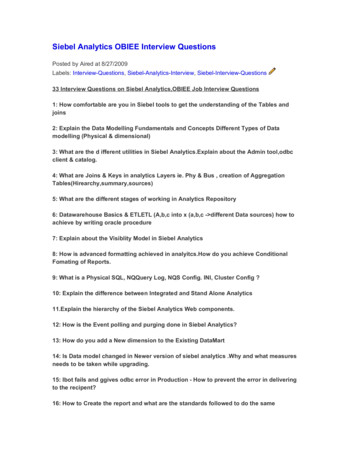

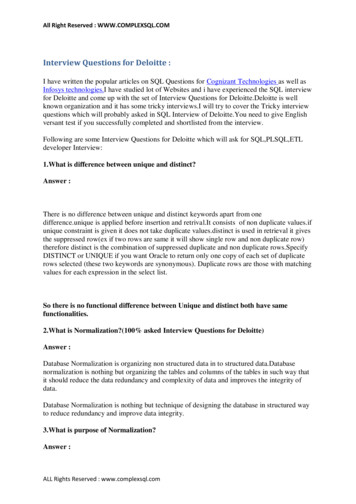
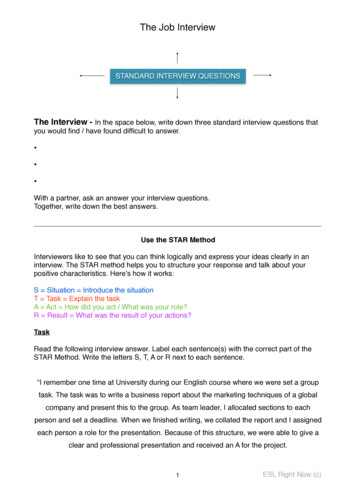
![Informatica Interview Questions and Answers [Scenario-Based]](/img/2/informatica-interview-questions-and-answers-scenario-based-1.jpg)
